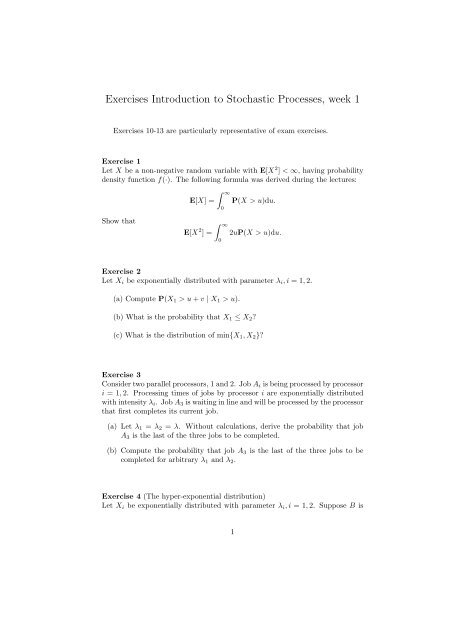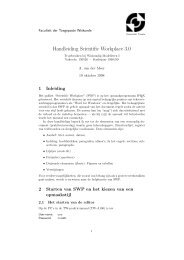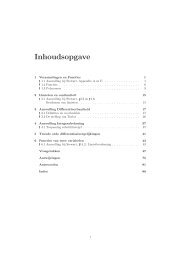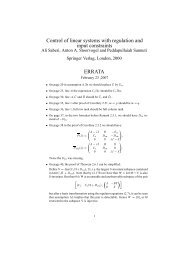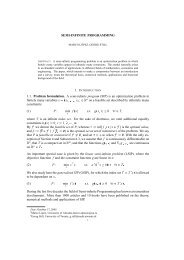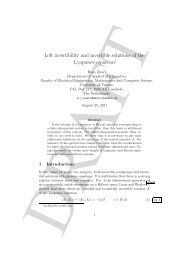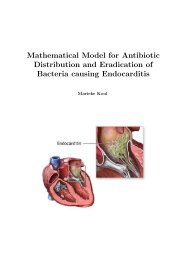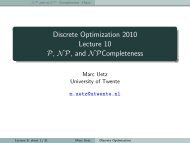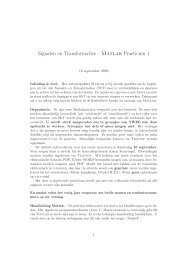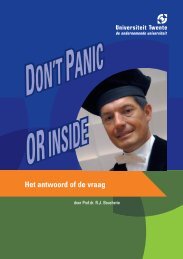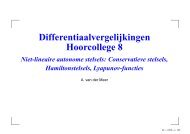Exercises Introduction to Stochastic Processes, week 1
Exercises Introduction to Stochastic Processes, week 1
Exercises Introduction to Stochastic Processes, week 1
You also want an ePaper? Increase the reach of your titles
YUMPU automatically turns print PDFs into web optimized ePapers that Google loves.
<strong>Exercises</strong> <strong>Introduction</strong> <strong>to</strong> S<strong>to</strong>chastic <strong>Processes</strong>, <strong>week</strong> 1<br />
<strong>Exercises</strong> 10-13 are particularly representative of exam exercises.<br />
Exercise 1<br />
Let X be a non-negative random variable with E[X 2 ] < ∞, having probability<br />
density function f(·). The following formula was derived during the lectures:<br />
E[X] =<br />
∫ ∞<br />
0<br />
P(X > u)du.<br />
Show that<br />
E[X 2 ] =<br />
∫ ∞<br />
0<br />
2uP(X > u)du.<br />
Exercise 2<br />
Let X i be exponentially distributed with parameter λ i , i = 1, 2.<br />
(a) Compute P(X 1 > u + v | X 1 > u).<br />
(b) What is the probability that X 1 ≤ X 2 ?<br />
(c) What is the distribution of min{X 1 , X 2 }?<br />
Exercise 3<br />
Consider two parallel processors, 1 and 2. Job A i is being processed by processor<br />
i = 1, 2. Processing times of jobs by processor i are exponentially distributed<br />
with intensity λ i . Job A 3 is waiting in line and will be processed by the processor<br />
that first completes its current job.<br />
(a) Let λ 1 = λ 2 = λ. Without calculations, derive the probability that job<br />
A 3 is the last of the three jobs <strong>to</strong> be completed.<br />
(b) Compute the probability that job A 3 is the last of the three jobs <strong>to</strong> be<br />
completed for arbitrary λ 1 and λ 2 .<br />
Exercise 4 (The hyper-exponential distribution)<br />
Let X i be exponentially distributed with parameter λ i , i = 1, 2. Suppose B is<br />
1
a random variable with P(B = 1) = p and P(B = 2) = 1 − p, with 0 < p < 1.<br />
Let Y be defined as follows: Y = X 1 if B = 1 and Y = X 2 if B = 2. Calculate<br />
P(Y > x) by conditioning on the values of B. Consequently, compute the<br />
density of Y .<br />
Exercise 5<br />
Let X 1 , X 2 , . . . be a sequence of independent, exponentially distributed random<br />
variables with common parameter λ.<br />
(a) Compute the density of X 1 + X 2 .<br />
(b) Using induction on n, show that the density of S n = ∑ n<br />
i=1 X i is given by<br />
−λt (λt)n−1<br />
λe<br />
(n − 1)! .<br />
Remark: This is the density of the Erlang distribution with parameters n<br />
and λ.<br />
(c) Verify that the above density is the derivative with respect <strong>to</strong> t of the<br />
Erlang distribution given in Ross.<br />
Hint: Use the following property: If X and Y are independent, non-negative<br />
random variables with densities f and g, respectively, then the density of X +Y<br />
equals ∫ t<br />
f(u)g(t − u)du.<br />
0<br />
Exercise 6<br />
Consider a Markov chain with transition probabilities p 12 = 1, p 21 = 1/2, p 23 =<br />
1/2, p 32 = 1/2 and p 33 = 1/2.<br />
(a) Determine the steady-state distribution of this Markov chain.<br />
(b) Determine the expected time it takes the process <strong>to</strong> return <strong>to</strong> state i (starting<br />
from i), for i = 1, 2, 3.<br />
Exercise 7<br />
Consider a Markov chain with transition matrix<br />
⎡<br />
⎤<br />
P =<br />
⎢<br />
⎣<br />
1 3<br />
0<br />
4<br />
0<br />
4<br />
0 0 1 0<br />
2<br />
0<br />
3<br />
1<br />
3<br />
0<br />
0 0 0 1<br />
Let X n ∈ {1, 2, 3, 4} be the state of the chain at time n = 0, 1, 2, . . .. Determine<br />
lim n→∞ P (X n = k|X 0 = 1}, k = 1, 2, 3, 4.<br />
⎥<br />
⎦ .<br />
2
Exercise 8<br />
The home page of the extremely popular T.E. Acher is regularly consulted by<br />
many students worldwide. New ‘visits’ <strong>to</strong> the home page by students occur according<br />
<strong>to</strong> a Poisson process with an average of 10 students per hour. Mr. Acher<br />
is also highly respected by colleagues. The average number of colleagues that<br />
visit the home page per hour is 2 (also according <strong>to</strong> a Poisson process).<br />
(a) What is the probability that the home page is visited at least twice during<br />
one hour?<br />
(b) What is the probability that the home page is not visited at all over the<br />
course of 15 minutes?<br />
A student that visits the home page ‘clicks’ on the link <strong>to</strong> an overview of<br />
Mr. Acher’s research activities with probability 2/5.<br />
(c) Determine the probability that during one working day (8 hours) exactly 1<br />
student consults the research overview.<br />
Exercise 9<br />
A processor is inspected <strong>week</strong>ly in order <strong>to</strong> determine its condition. The condition<br />
of the processor can either be perfect, good, reasonable or bad. A new<br />
processor is still perfect after one <strong>week</strong> with probability 0.7, with probability<br />
0.2 the state is good and with probability 0.1 it is reasonable. A processor in<br />
good conditions is still good after one <strong>week</strong> with probability 0.6, reasonable<br />
with probability 0.2 and bad with probability 0.2. A processor in reasonable<br />
condition is still reasonable after one <strong>week</strong> with probability 0.5 and bad with<br />
probability 0.5. A bad processor must be repaired. The reparation takes one<br />
<strong>week</strong>, after which the processor is again in perfect condition.<br />
(a) Formulate a Markov chain that describes the state of the machine and draw<br />
the transition probabilities in a network.<br />
(b) Determine the steady-state probabilities of the Markov chain.<br />
Exercise 10<br />
Consider the Markov Chain (X n ) n≥0 with state space {1, 2, 3, 4, 5, 6} and transition<br />
matrix:<br />
⎛<br />
⎞<br />
1<br />
2<br />
3<br />
0 0 0<br />
3<br />
0<br />
1 1 1 1<br />
0<br />
4 4<br />
0 4 4<br />
0 0 0 1 0 0<br />
⎜ 0 0 0 0 0 1<br />
(1)<br />
⎟<br />
⎝ 1 0 0 0 0 0 ⎠<br />
4 1<br />
0 0<br />
5 5<br />
0 0<br />
a) Draw the network of possible transitions and determine the classes of communicating<br />
states.<br />
b) Verify – for all possible initial states – whether there exists a limiting distribution<br />
and, if so, determine this distribution.<br />
3
c) Determine the probability that state 1 is ever reached, starting in state 2.<br />
Exercise 11<br />
Two types of consultations occur at a database according <strong>to</strong> two independent<br />
Poisson processes: “read” consultations arrive at rate λ R and ”write” consultations<br />
at rate λ W .<br />
a. What is the probability that the time interval between two consecutive ”read”<br />
consultations is larger than t?<br />
b. What is the probability that the first next arriving consultation is a ”read”<br />
consultation?<br />
c. What is the probability that during the time interval [0, t] at most three<br />
”write” consultations arrive?<br />
d. What is the probability that during the time interval [0, t] at least two consultations<br />
arrive?<br />
e. Determine the distribution of the number of arrived ”read” consultations<br />
during [0, t], given that in this interval a <strong>to</strong>tal number of n consultations occurred.<br />
Exercise 12<br />
Consider the route of a drunk visiting a collection of N + 1 bars numbered<br />
0, 1, . . . , N − 1, N. From bar i the drunk walks <strong>to</strong> bar i + 1 with probability p<br />
and <strong>to</strong> bar i − 1 with probability q = 1 − p, i = 1, . . . , N − 1. After visiting bar<br />
0 the drunk always goes <strong>to</strong> bar 1 and after bar N the drunk visits bar N − 1.<br />
X n denotes the position of the drunk after the nth walk.<br />
a) Determine the expected number of walks <strong>to</strong> reach bar 3 from bar 0.<br />
b) Assume p = q = 0.5. Determine the steady-state distribution of the Markov<br />
chain (X n ) n≥0 .<br />
Exercise 13<br />
The number of orders being processed at a fac<strong>to</strong>ry can be described by a Markov<br />
chain with state space {0, 1, 2, 3, . . .}. For a given positive integer N, the transition<br />
probabilities are P 0,0 = 0.5, P i,i+1 = 0.5 for i = 0, . . . , N, P i,i+1 = p<br />
for i = N + 1, N + 2, . . ., P i,i−1 = 0.5 for i = 1, . . . , N and P i,i−1 = 1 − p for<br />
i = N + 1, N + 2, . . .. Here, p < 0.5.<br />
(a) Why is this Markov chain irreducible, aperiodic and positive recurrent?<br />
(b) Determine the limiting distribution of the Markov chain.<br />
(c) Let N = 3. What is the expected number of transitions <strong>to</strong> reach state 3<br />
from state 0?<br />
4


